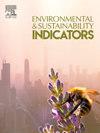基于地理空间指数和统计分析的城市湿地变化指标趋势分析及其启示
IF 5.4
Q1 ENVIRONMENTAL SCIENCES
引用次数: 0
摘要
达尔邦加市是狐果(Euryale ferox)和荸荠(Trapa bispinosa)的主要生产中心。1964年,该市有300个湖泊,到2023年减少到83个。对该地区城市湿地的研究较少。利用地理空间指数计算NDVI、MNDWI、NDBI、EBBI、NDMI、BSI、LULC和LULCC检测,探讨土地利用变化对城市湿地的影响,弥补研究空白。利用1989年、2000年、2010年、2020年和2023年的Landsat卫星数据对季风前和季风后两个季节的年代际变化进行了分析。EBBI对裸地面积的影响优于BSI。分析了建成区、城市人工林、水体和荒地四大类的变化检测。建成区面积的变化最为显著,从1989年的21.3%增加到2023年的59.8%。其他土地使用类别已经减少。Kappa系数描述了89%的优秀总体精度。1989年水域下面积为13.2平方公里。Km,减少到4.2平方公里。2023年。MNDWI和NDMI在季风前和季风后的结果有一个共同的趋势。结果表明:建成区面积正增加,水体明显减少;这可能导致花生产量减少,影响当地居民的生计以及城市与水有关的可持续性。本文章由计算机程序翻译,如有差异,请以英文原文为准。

Trend analysis of the indicators of urban wetland change and its implications using geospatial indices and statistical analysis
Darbhanga City is a major centre for producing fox nuts (Euryale ferox) and water chestnuts (Trapa bispinosa). The city had 300 lakes in 1964, reduced to 83 in 2023. There is a paucity of research on the urban wetlands of the area. The study attempts to bridge the research gap in the area by utilising geospatial indices to calculate NDVI, MNDWI, NDBI, EBBI NDMI, BSI, LULC, and LULCC detection to investigate the impact of land use change on the urban wetlands. Decadal analysis change was conducted using Landsat satellite data for 1989, 2000, 2010, 2020 and 2023, for two seasons: pre- and post-monsoon. EBBI showed better results for bare land area than BSI. Change detection was analysed for four major classes: built-up areas, urban plantations, water bodies, and barren land. The most significant change was observed for the built-up area, which increased from 21.3 % (1989) of the total land area to 59.8 % (2023). The other land use classes have decreased. The Kappa coefficient depicted an excellent overall accuracy of 89 %. The area under a water body in 1989 was 13.2 sq.km, which decreased to 4.2 sq.km in 2023. A common trend can be observed in pre- and post-monsoon results of MNDWI and NDMI. The results showed a positive increment of built-up area and a significant decline in the water body. This could result in a decrease in the production of foxnuts, impacting the livelihood of the local population as well as the water-related sustainability of the city.
求助全文
通过发布文献求助,成功后即可免费获取论文全文。
去求助
来源期刊

Environmental and Sustainability Indicators
Environmental Science-Environmental Science (miscellaneous)
CiteScore
7.80
自引率
2.30%
发文量
49
审稿时长
57 days
 求助内容:
求助内容: 应助结果提醒方式:
应助结果提醒方式:


